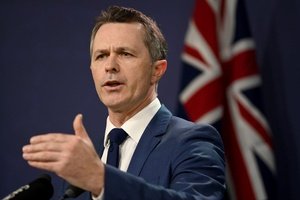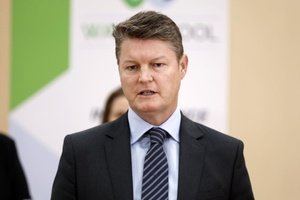The Institute contend that our governments have been too slow to draw a line through ‘faddish’ and discredited maths teaching methods in primary school classrooms, leaving teachers and school leaders to grapple with inconsistent and contradictory advice about what evidence-based practice actually entails.
For too long maths has been de-prioritised across the education system, the new report warns, and students’ mastery in the subject has been derailed by activity-based, ‘maths-lite’ learning in their foundational years.
This has left too many children with learning gaps that widen as they progress through school, the report flags.
The latest NAPLAN data shows the nation’s clear underachievement in maths, with one in three Australian students now failing to achieve proficiency.
This means that in a typical classroom of 24 students, eight will not be proficient in maths.
International tests echo a similarly alarming tale. In the 2023 Trends in International Mathematics and Science Study (TIMSS), 28 per cent of Year 4 students and 36 per cent of Year 8 students fell below the national proficiency benchmark.
Meanwhile, 2022 PISA results found almost half of our 15 year-olds failed to reach Australia’s PISA proficiency benchmark.
Put simply, “Australia has a maths problem”, the report declares.
But as Nick Parkinson, senior associate at Grattan Institute says, the good news is that we do know how to lift outcomes at scale.
“Governments across Australia have been too slow to take action on maths and … sometimes emphasise teaching [it] through activities.
“The idea here is for the students to have a lot of fun, and for students to investigate – through potentially openly-ended classroom activities – maths as it applies to real life.
“But the problem with this is, it’s not always in accordance with the evidence which suggests that these activities are best reserved for when students have mastery of the foundation skills,” he tells EducationHQ.
Fortunately, policymakers have begun the process of de-implementing their ‘bad guidance’, Parkinson says, but the real lever of change will be in the provision of implementation support and ongoing training for primary teachers to upskill.
This needs to be done with fidelity – not just upbeat media releases – if we want all students to be given a solid grounding in maths before they hit secondary school, he suggests.
“Teaching primary maths is less straightforward than governments have typically given it credit for.
“I think we’ve laboured under misconceptions that, ‘oh, in primary school, students are learning to count in the early years and subtract thereafter, and then eventually [they’ll tackle] complex things’…”
This view fails to acknowledge that it’s very difficult for young children to become proficient in quite abstract mathematical concepts, and underestimates the knowledge and skills teachers’ need to teach maths well and with confidence, Parkinson says.

“We need to be more systematic so that the way students are taught maths isn't a lucky dip,” researcher Nick Parkinson says.
Researchers also found examples of outdated and inconsistent guidance on department websites, even despite governments having made commitments to an explicit teaching approach.
“Different teams inside the same education department or its agencies often adopt different positions. And schools report that advice from regional office staff often varies considerably,” the report flags.
On top of this, teachers are also receiving mixed messages from their school leaders about how maths ought to be taught, a study carried out as part of the project found.
Involving 1745 primary teachers, Parkinson says this finding comes as no great surprise.
“We found that teachers reported that there wasn’t always agreement on the best way to teach maths, so fewer than half of teachers said that at their school there was a consensus on what an effective maths teaching approach entailed…”
Open-text responses unearthed split views on what effective maths instruction involves, with one Victorian teacher noting ‘disagreement about the best pedagogy’ was the biggest challenge to lifting maths results at her school.
A few teachers also expressed the ‘misconception’ that teaching maths explicitly is ‘passive’ or all about ‘rote learning’, with others sharing fears about using explicit instruction in the maths classroom, the survey found.
As one instructional leader from NSW reported, “there is a lack of teachers’ understanding of the incremental steps to build conceptual maths knowledge and how this knowledge builds across the curriculum.”
Of course, there are exemplar schools showing what’s possible when evidence-based maths instruction is adopted across the board.
Grattan researchers visited seven of these lighthouse schools to scrutinise their approach.
“They had leaders who understood the implications of the evidence base in maths teaching, and they had teachers who were really deeply committed to that evidence base,” Parkinson says.
Through a commitment to shifting teachers’ practice, students at these schools were genuinely excited for maths lessons, with one Grade 2 student even fist pumping in anticipation, Parkinson recalls.
“What they’ve noticed through changing their practices is that students are making more progress. They really look forward to maths, it was one of the parts of the school day that they were super excited about.
“In addition to that, teachers are feeling more successful every day – so we know it’s possible. We know that school leaders are key.”
Yet there’s a sense that these schools were simply lucky enough to stumble upon the evidence, and it should not be this way, the researcher says.
[It’s just that they happened to have] a principal who got it, that they had teachers who researched in their own time.
“We need to be more systematic so that the way students are taught maths isn’t a lucky dip.”
Parkinson says when it comes to high quality PD for primary maths teachers, current offerings need a ’significant step up’.
Fewer than half of all leaders surveyed reported there are high-quality professional development courses available to improve teachers’ maths knowledge.
Meanwhile, around two-in-five teachers agreed that external professional learning sharpened their understanding of common misconceptions, or built their knowledge of core topics like fractions.
Grattan is now calling on all governments, along with the Catholic and independent school sectors, to commit to a 10-year ‘Maths Guarantee strategy’.
The strategy involves a five-pronged action plan, proposing that governments should:
- Commit to a long-term goal of 90 per cent proficiency in numeracy, as measured by NAPLAN.
- Ensure schools have clear guidance on how to teach maths well and department staff should align on this.
- Equip schools with quality-assured curriculum materials and ‘rigorously evaluated’ maths assessments.
- Invest in high-quality PD to support all educators to implement best practice in classrooms.
- Improve monitoring and oversight through stronger school reviews and the introduction of a mandatory, research-backed early years numeracy screening tool.
“This strategy will require ambition and commitment,” Grattan’s education program director Dr Jordana Hunter says.
“But the costs of these reforms are modest – only about $67 per primary student per year – and affordable within existing budgets by giving maths the priority it deserves.”
Parkinson says the proposed learning targets might be aiming high, but they are entirely doable.
“Most students, if taught well, can learn maths and be proficient.
“So, if we get really high-quality teaching in every Australian classroom, for every day in primary school, there’s a good chance we can reach these targets.
“They’re ambitious, but they’re realistic.”
The Australian Education Union has not welcomed the report, saying “beefing up school and principal reviews” and setting up an independent oversight body to drive the curriculum were not the answer.
“It’s time for the Grattan Institute to leave teaching to the highly qualified and trained teaching profession,” federal president Correna Haythorpe said.















